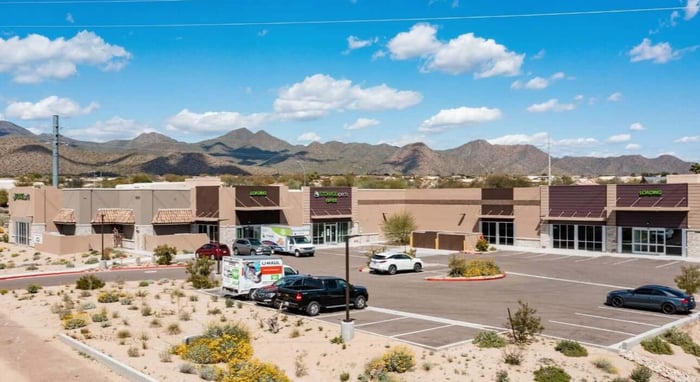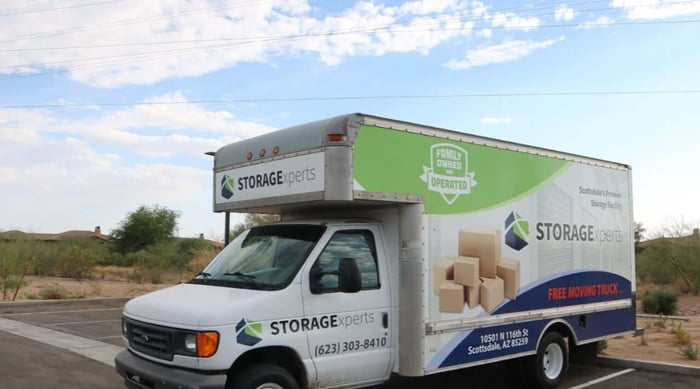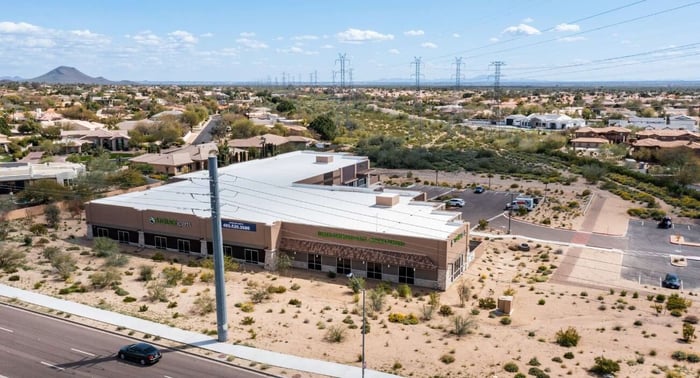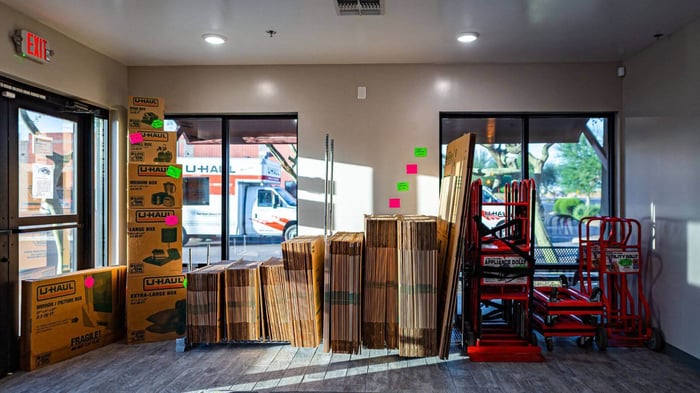Choosing between indoor and outdoor storage for your RV is one of the most critical decisions an RV owner can make. Each type of storage option comes with its pros, cons, and levels of protection, depending on your RV's size, usage, and the property where it's stored. Whether you're parking on a lot, beside your home, or at a commercial facility, selecting the right place can make all the difference. From shielding your investment from the elements to improving access and reducing wear, understanding the available types of storage helps guide the best decision.
At STORAGExperts, we help you choose the best way to store your RV with peace of mind. We break down the key information you need to know, highlight advantage of options, and ensure you don't overlook anything that could impact your RV's condition or value. On the one hand, indoor storage may provide superior protection; on the other hand, outdoor storage may offer more flexibility and lower costs. In addition, we explore how your budget, available space, and future travel plans influence the most effective long-term solution.
Determining the Right Storage Option Based on Your RV Type and Usage
Whether you own a Class A motorhome, camper, trailer, or tow-behind vehicle, your RV storage needs will vary. The size, weight, and condition of your car, as well as its frequency of use, will influence your choice of storage facility. Factors such as available space, spot availability, and the specific type of storage building —indoor, outdoor, or covered—can all affect your decision. Understanding the situation you're in, whether it's long-term parking or short seasonal storage, helps clarify the best solution for your needs.
RVs, trailers, and campers require storage that accommodates not only their dimensions but also the necessary space for maintenance and clearance on the ground. Some RV storage facilities offer a range of options, including units equipped with added benefits such as climate control, security cameras, and protection against the elements. When evaluating facilities, it's essential to ask the right questions and consider all aspects, from security and weather exposure to accessibility, to avoid future issues and protect your investment effectively.
Comparing Indoor and Outdoor Storage Based on Weather Protection
The most significant difference between indoor and outdoor RV storage options is their ability to shield your vehicle from the elements, including sun, rain, snow, wind, ice, and hail, as well as the added amenities, such as climate control or covered access, that often come with indoor solutions.
Indoor Storage Provides Full Weather Coverage
Indoor storage units function like a garage, featuring four walls, a roof, and often sealed doors and windows. These facilities protect your RV from:
- UV damage from the sun
- Roof wear due to hail or ice
- Rust and moisture buildup from rain, humidity, or snow
- Paint fading from prolonged temperature exposure
This type of storage is ideal if your RV is an investment you want to preserve in the long term. It also protects the interior—from appliances to seating—from temperature swings.
Outdoor Storage Offers Basic Coverage with Potential Risks
Outdoor RV storage typically includes open parking spots, driveway spaces, drive-up storage units, or partially covered storage units. While this option may be more budget-friendly, it leaves your vehicle vulnerable to:
- Pests, moisture, and wind damage
- Snow and rain accumulation on the roof
- Extreme temperatures that impact the tires, seals, and interior appliances
- Sun exposure causes fading and cracking
Owners storing trailers or motorhomes outdoors should consider additional protection such as covers, ventilation tools, and regular maintenance.
Weighing the Costs of Indoor and Outdoor Storage Units
Cost is a leading factor for most RV owners when selecting a storage facility. Prices depend on location, unit size, climate control, security, and accessibility. Exploring RV storage ideas to maximize your space can also help you get more value out of your chosen option, especially when space is limited or budget is tight.
Indoor Storage Involves Higher Monthly Investment
Indoor facilities typically offer premium services, which result in higher costs. Depending on your city, these rates can range significantly. Indoor units with added temperature control, humidity regulation, and insurance coverage often charge more but offer better durability and long-term savings by reducing the risk of repairs and damage.
Outdoor Storage Offers Affordability with Some Trade-Offs
Outdoor storage spaces are usually more affordable, especially in rural or suburban areas. While they may lack climate control, cameras, and extensive security systems, they are sufficient for short-term storage or seasonal RV users.
Budget-conscious RV owners must weigh the money saved against the risk of weather, vandalism, or the need for more frequent repairs.
Analyzing Security Features in RV Storage Facilities
 At STORAGExperts in Scottsdale, AZ, outdoor RV storage offers an affordable and convenient solution for owners who need regular access.
At STORAGExperts in Scottsdale, AZ, outdoor RV storage offers an affordable and convenient solution for owners who need regular access.Security is crucial when storing valuable vehicles, such as campers, trailers, or Class A RVs. A good RV storage facility includes:
- Surveillance cameras and security cameras
- On-site security systems and personnel
- Controlled access points and secure entry gates
- Proper lighting, fencing, and keypad entry systems
Indoor Facilities Provide Stronger Protection
Indoor storage units usually offer the most robust security features, including limited access, alarm systems, and 24/7 surveillance. This extra layer reduces the chances of theft, vandalism, or unauthorized access.
Outdoor Facilities Can Be Secure with the Right Setup
Many outdoor storage solutions also incorporate robust security measures, including cameras, fencing, and regular patrols. Selecting the correct location with adequate security coverage is crucial when choosing an outdoor storage unit.
Reviewing Accessibility and Convenience in Storage Facilities
Whether you need access weekly, monthly, or only during travel season, convenience is a key factor in your storage choice.
Indoor Storage Offers Controlled but Limited Access
Many indoor storage locations operate on set hours and may restrict access outside of these hours. Though more secure, it may be less convenient for spontaneous trips or emergency access.
Outdoor Storage Offers Flexibility
Outdoor RV storage typically offers 24/7 access, allowing owners to retrieve their vehicles at any time of day or night. This option is best suited for RV users who take frequent trips or require a quick turnaround time.
Protecting Your RV's Condition with the Right Storage Option
An RV's condition, from roof to tires, depends heavily on its exposure to external elements and how well it's maintained while in storage.
- Indoor storage preserves exterior finish, rubber seals, and interior electronics
- Outdoor storage requires more frequent inspection, pest control, and weatherproofing
Regardless of the storage type, regular care, repairs, and inspections are essential. Utilize tools such as ventilation aids, covers, and moisture-absorbing devices within your RV storage unit.
Considering Insurance and HOA Requirements
Some HOAs and cities have rules regarding RV parking in driveways, yards, or on public streets, making professional storage facilities not only preferred but also required.
Insurance Considerations
Some insurance providers may offer discounted premiums if your vehicle is kept in a secure, indoor, or gated facility. Be sure to confirm:
- Whether your insurance covers vandalism, theft, or storm damage
- If your storage unit offers additional coverage or requires separate policies
Evaluating Long-Term Value and Storage Investment
While cost is a short-term factor, value should guide your long-term decision. Indoor RV storage options may require higher monthly rates, but they can help reduce damage, prevent wear, and preserve resale value.
Outdoor storage, when correctly managed, remains an excellent solution for many owners, especially those with lower-cost vehicles or limited usage needs—a practical option STORAGExperts proudly offers across multiple secure locations.
Think of your RV storage facility as part of your investment strategy—just like maintenance, insurance, or repairs.
Key Steps to Choosing the Right RV Storage Facility
- Assess Your RV's Size and Type: Measure your vehicle and verify the unit's dimensions.
- Determine Usage Frequency: Regular travelers may need 24/7 access.
- Review Local Climate Conditions: Consider if sun, snow, or humidity affects your area.
- Compare Costs and Features: Weigh price, security, and maintenance trade-offs.
- Tour the Facility: Visit in person. Check surveillance, lighting, unit condition, and accessibility.
- Ask About Security: Are there security systems, cameras, or patrols in place?
- Understand Contract Terms: Look for flexibility, availability, and insurance policies.
- Check Reviews and Ratings: Look up online reviews, check ratings, and ask for references.
- Plan for Additional Equipment: Some locations offer tools, electrical hookups, or shelter for appliances and belongings.
Final Thoughts: Choosing the Storage Solution That Fits Your Needs
Every RV owner has different needs, preferences, and budgets. Whether you choose indoor storage with complete climate control and surveillance cameras or a more affordable outdoor storage unit, the decision should protect your vehicle, support your travel plans, and align with your investment goals.
At STORAGExperts, we offer a variety of RV storage options across multiple locations, featuring secure, accessible, and weather-protected units designed for every situation—from seasoned travelers to first-time campers. Explore our storage solutions today, and give your RV the care, shelter, and security it deserves.
Frequently Asked Questions (FAQs)
1. Can I perform maintenance or repairs on my RV while it's stored?
Some facilities allow light maintenance tasks, such as battery checks or tire inflation, while others may prohibit any mechanical work. Always check the rules of your chosen storage facility before planning any upkeep.
2. Are electrical hookups available in RV storage units?
Indoor and covered RV storage facilities often offer electrical outlets for charging batteries or for minor electrical use. This is a premium amenity and may incur additional fees or come with restrictions.
3. How can I protect my RV tires during long-term storage?
Use tire covers to block UV rays, and consider using tire cradles or boards to prevent flat spots if the RV will be stationary for an extended period. It's also wise to check and adjust pressure regularly.
4. What's the difference between covered and enclosed RV storage?
Covered storage provides a roof or overhead shelter but is open on a side. Enclosed storage is fully sealed with walls and doors, offering greater protection against weather, pests, and theft.
5. Do RV storage facilities offer pest control services?
Some higher-end facilities include pest control as part of their amenities or offer it as an add-on service. Ask the facility if they treat units or surrounding areas regularly to reduce infestations.
6. How early should I reserve RV storage before peak seasons?
It's best to reserve your spot at least 1–2 months in advance before the summer or winter travel seasons. Popular facilities can fill up quickly, especially in high-demand areas.
7. Can I store additional belongings or a towed vehicle with my RV?
Some storage units allow you to keep extra items, such as a tow dolly, generator, or camping gear, inside the unit or next to your RV. Be sure to ask about limitations and safety guidelines.
8. Is climate-controlled RV storage necessary in mild climates?
While not always essential, climate control can extend the life of your RV's interior, appliances, and seals—especially if you store high-end electronics or sensitive materials.
9. What happens if my RV gets damaged while in storage?
Liability depends on the storage facility's terms and your insurance. Verify whether your homeowner's or RV insurance policy covers damage to stored items or if additional coverage is required.
10. How do I prepare my RV for seasonal or long-term storage?
Clean the interior and exterior, remove perishables, disconnect the battery, cover tires and windows, and seal all entry points. Use moisture absorbers, and consider a breathable RV cover for outdoor storage to protect your vehicle from moisture.





